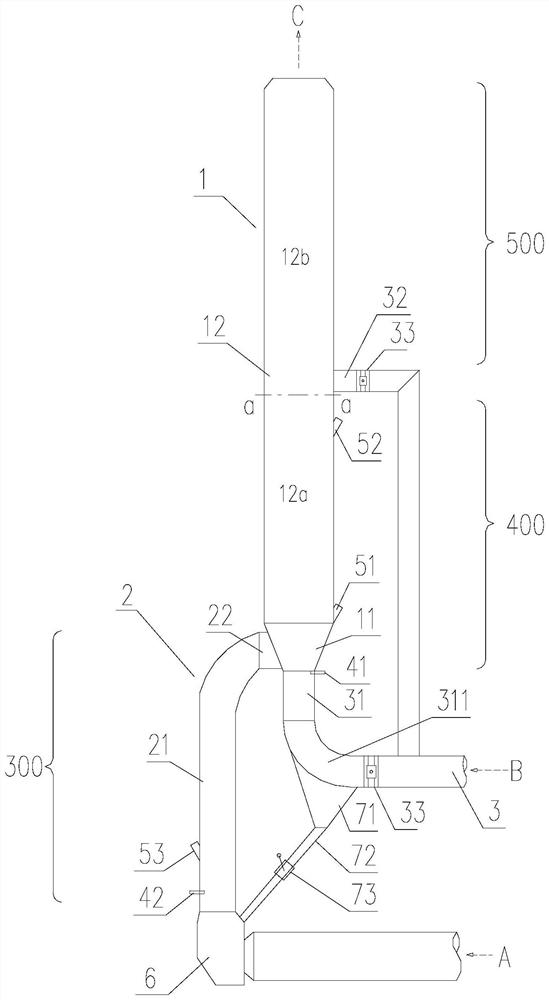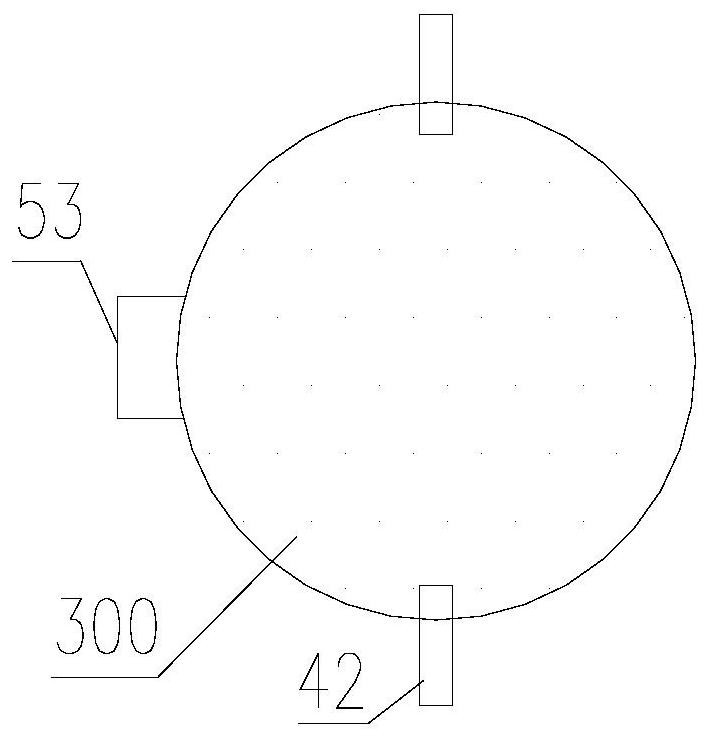A self-denitrification system and process for calciner compartmentalized combustion self-denitration
A technology of partition organization and decomposition furnace, which is applied in the direction of furnace components, furnaces, separation methods, etc., can solve the problems of short residence time of denitrification reaction, inability to reduce NOx, and limited space of oxygen-poor combustion area, so as to reduce the cost of environmental protection treatment of enterprises , increase the time of denitrification reaction, strong operability and practical effect
- Summary
- Abstract
- Description
- Claims
- Application Information
AI Technical Summary
Problems solved by technology
Method used
Image
Examples
Embodiment 1
[0061] see Figure 1~4 , the embodiment of the present invention provides a calciner compartmentalized combustion self-denitration system, including a rotary kiln, a kiln tail smoke chamber 6 connected to the rotary kiln tail, a calciner 1, a kiln connected to the kiln tail smoke chamber 6 and the calciner 1 Gas flue 21 and tertiary air duct 3; calciner 1, kiln gas flue 21 and tertiary air duct 3 are all equipped with refractory materials.
[0062]Rotary kiln flue gas A is the flue gas produced by fuel combustion in the rotary kiln. The temperature is generally 900-1150°C, the oxygen content is generally within 5%, and the NOx concentration in the flue gas is generally 800-1500ppm. The flue gas A of the rotary kiln moves upwards into the kiln gas flue 21 after passing through the kiln tail smoke chamber 6, and enters the calciner cone 11 through the furnace inlet 22 of the kiln gas flue. The furnace inlet 22 of the kiln gas flue is connected to the side of the calciner cone 1...
Embodiment 2
[0071] The difference from Embodiment 1 is that the calciner cylinder 12 is provided with a narrowing 13 in the middle of the calciner.
[0072] see Figure 5 . Preferably, the calciner column 12 is provided with a calciner middle neck 13 . The shrinkage 13 in the middle of the calciner is located below the upper feeding point 52 of the raw meal of the calciner. The raw meal that enters from the feed point 52 on the raw meal of the calciner moves downward under the action of gravity. By setting the neck 13 in the middle of the calciner, the cross-sectional wind speed at the neck becomes larger than that of the cylinder, which can effectively reduce the raw material. The falling height of the material can be adjusted to prevent material collapse in the calciner.
Embodiment 3
[0074] The difference from Embodiment 1 is that a column section 14 at the bottom of the calciner is provided between the calciner cone 11 and the furnace inlet of the lower branch pipe 31 of the tertiary air. The lower feed point 51 of the calciner raw material and the calciner fuel feed point 41 located below the inlet of the kiln gas flue are located on the column section 14 at the bottom of the calciner.
[0075] see Figure 6 . Preferably, a calciner bottom column section 14 is provided between the calciner cone 11 and the furnace inlet of the tertiary air lower branch pipe 31 . The tertiary air first passes through the column section 14 at the bottom of the calciner, and then enters the cone 11 of the calciner. At this time, the calciner fuel feed point 41 located below the inlet of the kiln gas flue and the lower feed point 51 of the calciner raw material are located on the column section 14 at the bottom of the calciner. The mixture of smoke and gas is more conduciv...
PUM
 Login to View More
Login to View More Abstract
Description
Claims
Application Information
 Login to View More
Login to View More - R&D
- Intellectual Property
- Life Sciences
- Materials
- Tech Scout
- Unparalleled Data Quality
- Higher Quality Content
- 60% Fewer Hallucinations
Browse by: Latest US Patents, China's latest patents, Technical Efficacy Thesaurus, Application Domain, Technology Topic, Popular Technical Reports.
© 2025 PatSnap. All rights reserved.Legal|Privacy policy|Modern Slavery Act Transparency Statement|Sitemap|About US| Contact US: help@patsnap.com



